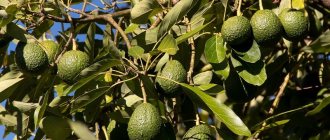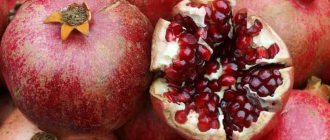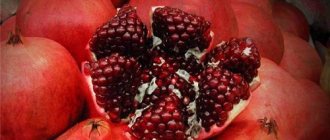How to choose a ripe pomegranate without cutting it
To identify a ripe specimen, it is not necessary to cut the fruits. You need to figure out how to choose the right pomegranates without compromising the integrity of the peel. This is determined by several criteria.
By appearance of the berries
Basic markers that help you select ripe fruits:
- Peel. Ripe specimens of different varieties or from different countries have different colors. Classic deep pinks and reds are complemented by reddish-brown, soft green or yellowish shades. In any case, the background of high-quality ripe specimens is distinguished by uniformity, uniformity and lack of spotting. Brown, brown spots are a sign of rot in the fruit. The skin of a ripe fruit is dry, matte and dense, reminiscent of the bark of a young tree. It looks as if it is stretched: the relief of the grains appears through it. The moisture and elasticity of the peel indicate that the fruit was picked unripe, it was ripened artificially.
- Top of the head. A ripe berry has a lid on the top that is open and dry. Immature ones are green.
- Pedicel. If it has been preserved, then you need to select specimens with dried, framed by dry sepals. Green, with wet or rotten fragments - defective.
If the fruits received are unripe, but without signs of spoilage, you need to let them rest.
Good fruits are free from dents or cracks.
By weight of pomegranate
The question of how to determine the ripeness of a pomegranate can be solved by its mass. For exotics, the rule works: the larger the fruit, the better.
The minimum diameter of a high-quality fruit is 8-9 cm. If possible, take specimens from 10 cm. If they are ripe, they will weigh half a kilo.
With equal sizes, it is better to choose a heavier specimen: this pomegranate is tastier and juicier. This is the highest quality option.
In large but light fruits, the process of grain drying has begun. They don't have enough juice.
By sound
Ripe pomegranate is easy to select as follows:
- lightly squeeze: in a ripened specimen, the grains crunch;
- when tapped, the ripe fruit produces a ringing, “metallic” sound;
- An unripe pomegranate gives itself away with a dull sound.
Pomegranates are selected for ripeness in the same way as watermelons.
Whether it is possible to eat unripe pomegranates is up to everyone to decide for themselves. This is not fatal, but unpleasant consequences are possible. It all depends on the degree of immaturity (great or not) of the fruit and the characteristics of the body. Their taste is also not for everyone.
What else should you pay attention to when buying a pomegranate?
Choosing a pomegranate can be compared to choosing a watermelon. The same approach is often applied to both. Pomegranates are also “tapped” and, first of all, specimens with a dry tip are selected. So, how else can you test fruits for ripeness:
- Tap the pomegranate with your index finger. If the sound is dull, there is a lot of emptiness inside. The juicy fruit sounds loud. You can compare it to the ringing sound of metal.
- Pay attention to the brightness of the color. Pallor of the peel often indicates a large amount of acid. But there are also exceptions to the rules. For example, seedless varieties, which are often light in color.
- If the seller helpfully cut off the “lid”, evaluate the shape of the grains. Ripe and sweet pomegranate seeds are oblong and have a well-defined ribbed surface. A round shape is a sign of immaturity.
- Smell the fruit. Unlike apples, strawberries and peaches, ripe pomegranates do not emit any flavor at all. Unripe fruits smell.
- Press down on the inflorescence. A crunch sound is a good signal. It means that ripe grains crack under pressure.
We recommend: Who should not eat spinach and why is it good for others?
Ways to preserve the harvest until spring
The problem of how to store pomegranate at home can be solved. The fruit is an inhabitant of the subtropics, so you need to create a “native”, soft regime for it.
Refrigerator storage
You can choose this storage method if the refrigerator provides a positive temperature (2-9°C) and a humidity of 70-75%:
- Washed and dried ripe specimens should be placed in the “fruit” compartment. Under-dried pomegranates will begin to mold.
- Each fruit is wrapped in parchment paper - freshness will last longer. Plastic bags, even unsealed, are not suitable. During storage, moisture will still appear inside and the pomegranates will spoil.
- The presence of “neighbors,” including vegetables, does not affect the condition of exotics.
Freezer
This method is suitable if you need to maximize the shelf life of fruits. The freezer will preserve their condition from several months to a year.
However, you should not freeze ripe pomegranates entirely:
- the fruits are bulky and “steal” a lot of space;
- cleaning takes a long time and is troublesome;
- When defrosting, due to temperature changes and skin pressure, the grains burst and the juice flows out.
How to choose ripe and sweet pomegranate when buying in a store or at the market
With the onset of winter, my family and I actively rely on natural vitamins and eat a lot of fruits - apples, tangerines, pomegranates. The latter are considered one of the most useful, so they should be added to the daily diet, especially for older people and small children. The counters of markets and shops are filled with an abundance of fruit that is so dizzying that you can get confused at first. I will teach you how to choose a ripe and sweet fruit on the first try and definitely not make a mistake.
They are brought to our country from South America, the Mediterranean, and the Middle East. In the Northern part of the world, the harvest begins in September and lasts until January. In Egypt, for example, the harvest ripens earlier than other countries, from about mid-September. In October, early varieties planted in Transcaucasia and Central Asia reach ripeness. In the south, the season lasts from March to May. It turns out that pomegranates are available all year round, they are just brought from different parts of the world.
The pomegranate tree is considered whimsical, but in comfortable warm conditions it bears fruit annually and lives up to 100 years.
To prevent the goods from going missing, they are often transported while still unripe. Those fruits that are almost ready to ripen are picked, and they ripen on the way to us. However, if you pick a pomegranate that is not yet ripe, it will still not have time to ripen to the end, so it will be sour and tasteless. During long-term transportation, the integrity of the fruit sometimes suffers: the skin cracks, breaks appear, and dirt gets into them, and fermentation begins. If you don’t want to run into a product of poor quality and spoil your mood, remember and use my advice in everyday life.
How to select and store pomegranate: general rules
The choice and method of storing pomegranates is determined by the variety, degree of ripeness and initial conditions of the fruit. General principles to consider:
- To store for the winter, you need to select only selected ones - undamaged, dry, “woody” specimens.
- Fruits with a soft or moist crust are pre-dried.
- Optimal storage conditions for exotics: temperature above zero, maximum 10°C, humidity 60-70%. Illumination and humidity when storing fruits should be selected at medium levels. In twilight, pomegranates feel more comfortable than in bright light or pitch darkness. At high humidity they will rot, at low humidity they will dry out.
- To store fruits in the basement, apartment, or on the balcony, wooden, cardboard or plastic containers are used. You should choose not a “solid” one, but a ventilated one, with holes.
- It is necessary to regularly inspect the backing of the container: if it becomes moist or looks suspicious, replace it with a new one.
- Each fruit is wrapped in paper. It is better to choose regular or baking parchment. They will absorb excess moisture. Sheets with printing ink (newspaper or magazine gloss) are not suitable: the ink will saturate the peel.
- The stock must be sorted regularly, removing spoiled specimens. Otherwise, the “epidemic” will affect other fruits. Selected spoiled pomegranates are processed immediately, separating the grains suitable for consumption from the total mass.
- If only the peel is spoiled, the grains are reconsidered and filled into a plastic bag or plastic container. The container must be closed and placed in the freezer. Quick-frozen ripe grains can be stored for up to a year.
How to identify a spoiled pomegranate
In supermarkets, goods are arranged by grade, indicating the exporter. In the general mass, it is noticeable which of them are of poor quality. When choosing, pay attention to:
- uniform color; if the surface is paler, the fruit is not ripe;
- for mechanical damage or cracks. If any are present, it is better to refrain from purchasing;
- on the surface and sepals. If the peel is smooth and the crown is not dry, the fruit is green.
Pay attention to black areas and dents on the surface. They indicate the beginning of decay.
How to choose ripe and sweet pomegranates in the store and on the market
First of all, never buy groceries hastily. While running, you can’t look at the product and have to grab what comes to hand, and when you get home you will be disappointed.
Pomegranate, like any other crop, has characteristic signs of maturity. They are expressed as follows:
- thin, slightly dried skin without visible damage. There should be no mold or cracks on it. Wet and elastic skin indicates that the berry was picked prematurely;
- intense brown color. The color depends on the variety grown, but most will have a reddish tint or brown;
- heavy weight A fully ripened fruit will weigh at least 300 g, more often 400-500 g;
- form. Don't look at perfectly round fruits; when the grains ripen, one part becomes larger than the other, so there will be asymmetry;
- smell. Smell the pomegranate; if the fruit is not overripe, there will be no aroma from it. If you can clearly smell the wine, the pulp is most likely fermenting;
- crown. There is always an open cup on one side of the fruit. Pay attention to its color and touch it. When mature, it will be dry and brown;
- sound. Ripe berries crunch appetizingly when you press them with your fingers. This is how the grains inside crack. A dull sound indicates immaturity.
If you have assessed most of the parameters and are convinced that the fruit has reached maturity, then feel free to buy it. Otherwise, put it aside and don't waste your money.
Benefits of fruit
The pomegranate fruit is a berry with a thick skin. Its weight often exceeds 500 g. The fruit contains a large number of elongated ribbed grains. Depending on the variety, pomegranates can vary in hardness. They contain a large number of useful elements that help treat colds and anemia. There is another advantage: berry juice is an excellent antioxidant, which is an excellent means of preventing cancer.
This crop is highly valued by doctors, because these berries contain a large amount of iron. Eating pomegranate fruits prevents diseases such as anemia. And a large number of vitamins counteracts infection with tuberculosis, dysentery and E. coli.
According to doctors, this culture is one of the most useful and universal. It strengthens the immune system and helps the body fight many diseases. The level of antioxidants in the king fruit is higher than in blueberries, citrus fruits or green tea.
Pomegranate is also valued in cosmetology. The combination of nasturtium flowers and pomegranate fruits allows you to create one of the most effective skin peels, which is an excellent means of combating harmful environmental factors. The juice of these berries is often used in making face masks. Its chemical composition, rich in vitamins and minerals, makes the skin smooth and soft. Despite the origin of the plant from North Africa and the eastern coast of the Mediterranean, gardeners have adapted to growing it in our harsh conditions. But without knowing the specifics of growing pomegranate, you may encounter difficulties related to its fruiting.
How do you know when the crop can be harvested?
And although the fruits can be harvested as early as mid-October , sometimes their taste is poor at this time. To avoid such problems, you need to know some recommendations:
- The fruit grains should have an oblong shape and a ribbed surface. Unripe grains have a round shape.
- The color of the peel should be bright. There may be pink and burgundy fruits. Pallor indicates the presence of acid.
- The skin should be intact, dry and thin. If there are cracks on it, then the berry is overripe.
- There should be a ringing metallic sound when tapping. Green fruit has a dull sound.
- Ripe fruit does not emit any aroma. But unripe pomegranate smells strongly.
- When the pomegranate ripens, it becomes elastic. Softness and spots on the peel indicate the process of rotting.
- A ripe fruit only appears light in appearance; its weight directly depends on the size of the juicy grains. A heavy pomegranate is very juicy, while an unripe one is light.
- You can determine the ripeness of a fruit by its inflorescence. The flower must be dry, ripe and without any greenery.











